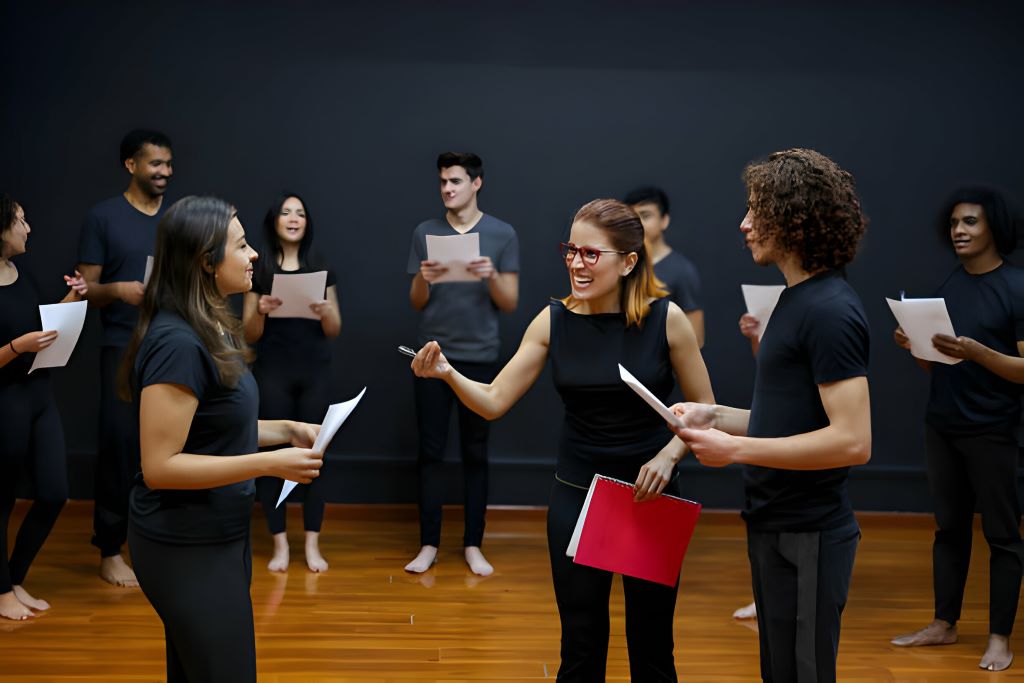The art of appearing is a complex and nuanced craft, extending past the mere recitation of strains. It needs a profound comprehension of emotions, acting class, body language and the ability to embody diverse characters authentically.
Within the world of appearing arts the function of formal training, often located in drama colleges, universities or specialized performing studios, is pivotal.
This based education serves as a crucible wherein uncooked talent is refined into flexible performers capable of fascinating audiences across diverse mediums.
Building Foundations
Central to the adventure of an actor is the understanding that their craft is malleable and may be honed via schooling and exercise.
The curriculum inside those packages spans an extensive spectrum, encompassing voice modulation, motion, script evaluation improvisation, and individual improvement.
Actors encounter numerous appearing strategies for the duration of their education, together with Stanislavski’s method, Meisner’s method, and Brechtian fashion.
Embracing Versatility for Success in the Industry
Acting classes Agency act as the cornerstone for aspiring performers, offering an essential introduction to the fundamental principles of the craft. Throughout this formative phase, students immerse themselves in the language and techniques of acting, gaining valuable insights into the mechanics of theatrical expression.
In the Online Diploma of Screen and Media in Specialist Make-up Services, foundational classes for makeup artists encompass crucial aspects such as stage presence, character development, and expressing emotions.
These classes serve as the essential groundwork, teaching the significance of makeup in conveying expressions and contributing to effective acting. They play a pivotal role in facilitating students’ progression and evolution as skilled makeup artists and actors.

The Acting Techniques Tapestry
Actors come across numerous acting techniques in the course of their education, each contributing to their unique creative palette. Stanislavski’s approach, Meisner’s method, and others end up threads woven into the fabric of an actor’s style.
1. Stanislavski’s Method
At the coronary heart of modern-day performing strategies lies Konstantin Stanislavski’s groundbreaking method.
Developed in the early 20th century, this technique emphasizes realistic portrayal by delving into the psychological and emotional elements of characters.
Stanislavski’s method includes actors drawing on their own reports to evoke true emotions, developing a more authentic and immersive overall performance.
2. Meisner’s Approach
In assessment, the Meisner Technique, evolved through Sanford Meisner, specializes in spontaneous, truthful reactions inside the moment.
Meisner places a substantial emphasis on listening and responding, fostering genuine interactions between actors.
Practitioners of the Meisner Technique learn to be fully present, allowing organic and unscripted moments to unfold during performances through repetitive exercises.
3. Brechtian Style
Bertolt Brecht, a pioneering parent in 20th-century theater, introduced a style that aimed to create a critical, reflective target market.
The Brechtian method seeks to break the illusion of conventional theater, encouraging actors to consciously distance themselves from their characters.
This approach involves direct address to the audience, alienation effects, and a focus on social and political issues.
4. Method Acting
Popularized by Brando and refined by Strasberg, Method Acting involves intense emotional and mental immersion into a character.
Actors’ training approaches often blur the traces between their on-display screen or on-level personas and their real lives, looking to live and breathe the character even away from digital cameras.

Practical Application and Feedback
Acting schooling goes beyond theory, emphasizing sensible utility. Rehearsals, workshops, and stay performances offer college students with the opportunity to apply their mastering in an actual-world context.
These studies teach adaptability, collaboration with peers, and responsiveness to live audiences. Through an iterative technique of studying and remarks, actors study to research their performances objectively, perceive areas for improvement, and refine their talents constantly.
The Journey of Self-Discovery
Acting schooling turns into a private odyssey, pushing individuals to discover and recognize themselves on a deeper stage. This self-attention complements their potential to carry authenticity to their roles.
A. Emotional Reservoirs
To authentically portray characters, actors ought to tap into their emotional reservoirs. In doing so, they embark on an adventure within, exploring the nuances in their personal emotions and studies.
This emotional self-discovery will become the cornerstone for developing performances that resonate with authenticity.
B. Empathy and Understanding
As acting class actors strive to realize the motivations and struggles of the characters they portray, they inevitably develop a heightened sense of empathy.
This empathic connection not only enhances performances but also deepens the understanding of human nature and the intricate tapestry of emotions that define us.
C. The Mirror of Performance
Acting serves as a reflective reflection, permitting people to look at themselves in the technique of embodying various characters.
This introspective element of the craft compels actors to confront their own vulnerabilities, strengths, and intricacies, leading to deeper information in their very own psyche.

D. Challenging Comfort Zones
The system of self-discovery frequently involves stepping outside one’s comfort region. This willingness to step into the unknown fosters personal boom and resilience.
Acting schooling pushes individuals to confront fears, include vulnerability, and undertake preconceived notions about themselves.
E. Adapting to the Changing Landscape
In an era where technology reshapes various facets of our lives, the field of acting is no exception.
Aspiring actors are now navigating the dynamic landscape of digital platforms, and acting class has swiftly adapted to this paradigm shift, incorporating new mediums and technologies into its curriculum.
Conclusion
The adventure from beginner to pro expert entails a transformative method in the international of appearing, serving because the nexus among tradition and innovation, formal training remains integral in shaping the destiny of the performing arts.
Through theory, practice, and feedback, actors develop a sculpted prowess to navigate the ever-evolving world of acting class performance.



